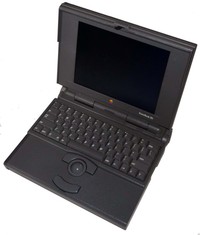Apple Macintosh PowerBook 150
| Home > Browse Our Collection > Computers > Apple Computers > Apple Macintosh PowerBook 150 |
|
The Apple Macintosh PowerBook 150 was a laptop personal computer created by Apple Computer which was introduced on July 13, 1994 and released on July 18, 1994. It was the last member of the PowerBook 100 series to use the original case design. It was the most affordable of the series when introduced, priced between $1450 and $1600, and also the last consumer model. It was 8 MHz faster than its predecessor, the PowerBook 145B. It lacked an ADB port and used a lower quality passive matrix display than other current offerings, both to reduce the price. Like the Duos & PowerBook 100 before it, the 150 only had a single serial printer port, however, a third party adapter was available for use in the optional modem slot. Though it used the 140 case design, its internals were based on the PowerBook Duo 230 and actually more similar to the features of the PowerBook 190 (which used the PowerBook 5300's case design). Notably, this new logicboard design allowed this 100 series PowerBook to use more than 14 MB RAM for the first time, as well as the first Macintosh ever to use less expensive and larger IDE drives (formatting required a unique software application limiting the selection of compatible drives). It was also the first of the 100 series to include a lithium-ion backup battery to preserve RAM contents when the battery is replaced. This was the last PowerBook model to include a trackball. However, like the 145B it replaced, the 150 could not be used in SCSI Disk Mode, unlike the Duo, 190 and 5300 which had HD Target Mode implemented. Processor: Motorola 68030, running at 33 MHz Our machine has a model number of M2740 and a serial number of EE5081 KU3AK. Manufacturer: Apple Comment on This Page Magazines RELATED to Apple Macintosh PowerBook 150 in our Library
Other Systems Related To Apple Macintosh PowerBook 150:This exhibit has a reference ID of CH25710. Please quote this reference ID in any communication with the Centre for Computing History. |
Click on the Image(s) For Detail
|


























